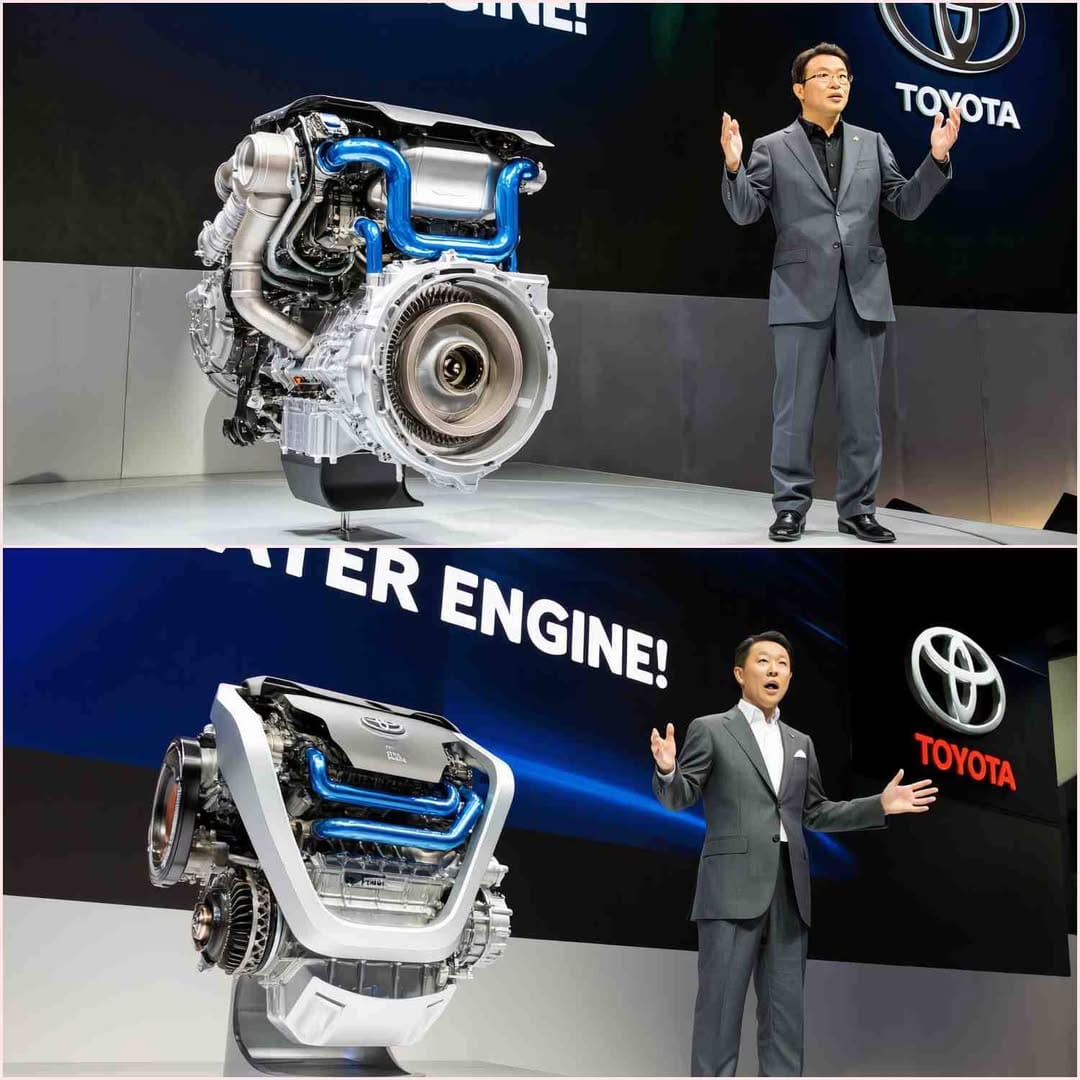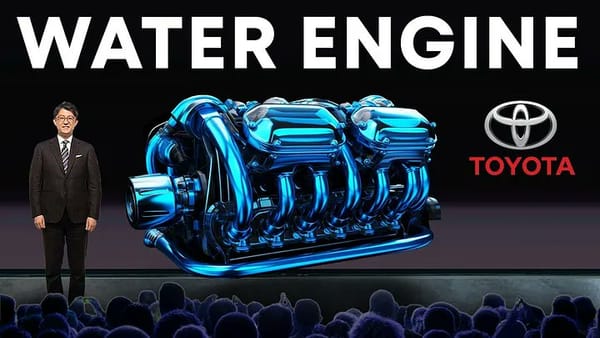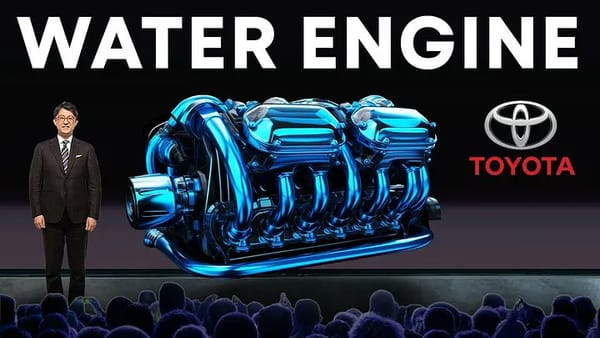Toyota’s Bold Leap Toward Sustainability
Toyota has long been a trailblazer in the automotive world, from launching the world’s first mass-produced hybrid, the Prius, to pioneering hydrogen fuel cell vehicles like the Mirai. In recent years, the term "Toyota water engine" has sparked widespread curiosity, with online rumors suggesting Toyota developed an engine that runs directly on water. In truth, this "water engine" refers to Toyota’s cutting-edge hydrogen technologies—fuel cells and combustion engines—that produce water vapor as their primary emission, earning the nickname. As the world grapples with climate change and the urgent need for cleaner transportation, Toyota’s hydrogen innovations are emerging as a game-changer in sustainable mobility.
In 2025, with global emissions targets tightening and consumer demand for eco-friendly vehicles rising, Toyota’s hydrogen technology offers a promising alternative to traditional gasoline cars and battery electric vehicles (EVs). This article takes an in-depth look at the so-called Toyota water engine, exploring how it works, its environmental and practical benefits, and the challenges it faces. We’ll debunk myths, compare hydrogen vehicles to EVs, and examine Toyota’s vision for a hydrogen-powered future. Whether you’re a car enthusiast, an environmental advocate, or simply curious about the future of driving, this guide will provide a clear and comprehensive understanding of Toyota’s revolutionary technology.
What Is the Toyota Water Engine? Clearing Up the Confusion
The phrase "Toyota water engine" has gained traction online, often accompanied by sensational claims that Toyota invented an engine powered directly by water. These claims are misleading and stem from a misunderstanding of Toyota’s hydrogen-based technologies. The "water engine" nickname refers to two distinct innovations: hydrogen fuel cell vehicles, like the Toyota Mirai, and hydrogen combustion engines, both of which emit water vapor as a byproduct. Let’s break down the reality behind the hype.
The Myth of the Water-Powered Engine
The idea of a car running on water alone is a persistent myth, fueled by viral social media posts and speculative articles. Scientifically, water cannot serve as a fuel source because it is a stable compound requiring significant energy to break down into hydrogen and oxygen. Toyota’s technology, however, uses hydrogen as the fuel, which, when processed in a fuel cell or burned in a combustion engine, reacts with oxygen to produce electricity or power, leaving only water vapor as the exhaust. This clean output has led to the "water engine" label, but the fuel is hydrogen, not water.
Hydrogen Fuel Cells: The Heart of Toyota’s Innovation
Toyota’s flagship hydrogen fuel cell vehicle, the Mirai, uses a fuel cell stack to generate electricity. Hydrogen stored in high-pressure tanks combines with oxygen from the air in an electrochemical reaction, producing electricity to power an electric motor. The only emission is water vapor, making it a true zero-emission vehicle. This technology is the cornerstone of Toyota’s sustainable mobility strategy.
Hydrogen Combustion Engines: A Familiar Alternative
In addition to fuel cells, Toyota is developing hydrogen combustion engines, which adapt traditional internal combustion engine (ICE) designs to burn hydrogen instead of gasoline. These engines produce water vapor and minimal pollutants, offering a familiar driving experience with a significantly reduced environmental impact. Toyota has tested hydrogen combustion in motorsports, showcasing its potential for high-performance applications.
Why It’s Called the "Water Engine"
The "water engine" nickname arises because both hydrogen fuel cells and combustion engines emit water vapor, creating the impression of a water-based system. However, the real innovation lies in hydrogen’s potential as a clean, sustainable fuel when produced using renewable energy sources.
How Toyota’s Hydrogen Technology Works
Understanding the mechanics of Toyota’s hydrogen technology is key to appreciating its potential. Whether through fuel cells or combustion engines, Toyota’s systems are designed to deliver clean, efficient, and practical performance. Here’s a closer look at how they work.
Hydrogen Fuel Cells: Powering the Mirai
The Toyota Mirai’s fuel cell system operates on a simple yet sophisticated principle:
- Hydrogen Storage: The Mirai stores compressed hydrogen gas in high-pressure tanks, typically at 10,000 psi, ensuring safety and efficiency.
- Fuel Cell Stack: In the fuel cell stack, hydrogen molecules react with oxygen from the air across a catalyst, generating electricity through an electrochemical process.
- Electric Motor: The electricity powers an electric motor, delivering smooth, quiet performance similar to an EV.
- Emission: The only byproduct is water vapor, expelled through the vehicle’s tailpipe.
This system provides a driving range of up to 402 miles (EPA-estimated for the 2025 Mirai), comparable to many gasoline vehicles, and refueling takes just 3-5 minutes at a hydrogen station.
Hydrogen Combustion Engines: Reinventing the ICE
Toyota’s hydrogen combustion engines burn hydrogen in a modified internal combustion engine, similar to a gasoline engine. Key differences include:
- Fuel Delivery: Hydrogen is injected into the engine’s cylinders, where it combusts with oxygen.
- Emissions: The primary output is water vapor, with trace amounts of nitrogen oxides (NOx) that are far lower than gasoline engine emissions.
- Performance: These engines deliver the familiar power and sound of traditional ICEs, appealing to drivers who prefer conventional driving dynamics.
Toyota has tested hydrogen combustion engines in vehicles like the Corolla Sport, competing in endurance races to demonstrate their durability and performance.
Hydrogen Production: The Key to Sustainability
Hydrogen must be produced before it can be used as fuel. The most common methods are:
- Electrolysis: Splitting water into hydrogen and oxygen using electricity, ideally from renewable sources like solar or wind.
- Steam Methane Reforming: Extracting hydrogen from natural gas, which is less sustainable due to CO2 emissions.
Toyota is investing in green hydrogen production, using renewable energy to minimize the environmental impact of hydrogen sourcing.
Advances in Hydrogen Storage
Toyota’s high-pressure hydrogen tanks are made from lightweight, durable materials like carbon fiber, ensuring safety and maximizing range. These tanks undergo rigorous testing to withstand crashes and extreme conditions, addressing public concerns about hydrogen’s flammability.
Benefits of Toyota’s Hydrogen Technology
Toyota’s hydrogen technology offers compelling advantages, making it a viable contender in the race for sustainable transportation. From environmental benefits to practical performance, here’s why it matters.
Environmental Advantages
- Zero Tailpipe Emissions: Hydrogen fuel cells produce only water vapor, eliminating CO2 and harmful pollutants from vehicle operation.
- Reduced Fossil Fuel Reliance: When produced using renewable energy, hydrogen reduces dependence on finite fossil fuels.
- Cleaner Air: Hydrogen vehicles contribute to improved air quality, especially in urban areas with high traffic.
Performance and Convenience
- Long Driving Range: The Toyota Mirai offers up to 402 miles of range, surpassing many EVs and rivaling gasoline cars.
- Fast Refueling: Hydrogen refueling takes 3-5 minutes, compared to hours for EV fast charging.
- Cold-Weather Performance: Unlike some EVs, hydrogen vehicles maintain efficiency in cold climates, making them versatile for diverse regions.
Economic and Societal Benefits
- Job Creation: Expanding hydrogen infrastructure could create jobs in production, distribution, and refueling sectors.
- Energy Diversification: Hydrogen offers an alternative to battery-based EVs, reducing strain on lithium and cobalt supplies.
- Scalability: Hydrogen technology can power not just cars but also trucks, buses, trains, and stationary generators, broadening its impact.
Toyota’s Competitive Edge
Toyota’s decades of experience with hybrids and fuel cells give it a head start in hydrogen innovation. The Mirai’s success and Toyota’s motorsport testing demonstrate the technology’s reliability and potential.
Challenges Facing Toyota’s Hydrogen Technology
Despite its promise, hydrogen technology faces significant hurdles that must be addressed for widespread adoption. Understanding these challenges provides a balanced perspective on Toyota’s "water engine."
Limited Refueling Infrastructure
As of 2025, hydrogen refueling stations are scarce, concentrated in regions like California (over 50 stations), Japan, and parts of Europe. This limits the practicality of hydrogen vehicles for many consumers, unlike EVs, which benefit from a growing network of charging stations.
High Production Costs
Producing green hydrogen via electrolysis is energy-intensive and expensive, requiring abundant renewable energy to be sustainable. Most hydrogen today is "gray," derived from natural gas, which generates CO2 and undermines environmental benefits.
Competition with Electric Vehicles
EVs dominate the zero-emission vehicle market, with widespread charging infrastructure, lower vehicle costs, and government incentives. Hydrogen vehicles, while offering faster refueling, are more expensive upfront and face infrastructure barriers.
Public Perception and Safety Concerns
Hydrogen’s flammability raises safety concerns among consumers, despite Toyota’s rigorous testing of hydrogen tanks. Public education is needed to dispel myths and build trust in hydrogen technology.
Scaling Production
Scaling up green hydrogen production requires significant investment in renewable energy and electrolysis facilities. Without global cooperation, the transition to sustainable hydrogen could be slow.
The Toyota Mirai: A Showcase of Hydrogen Innovation
The Toyota Mirai is the flagship of Toyota’s hydrogen ambitions, embodying the "water engine" concept. Launched in 2014 and updated in 2021, the second-generation Mirai is a sleek, practical, and eco-friendly vehicle that demonstrates the potential of hydrogen fuel cells.
Key Features of the Mirai
- Range: Up to 402 miles (EPA-estimated), ideal for long-distance travel.
- Refueling Time: 3-5 minutes at a hydrogen station, offering convenience similar to gasoline vehicles.
- Design: A luxurious sedan with a modern aesthetic, advanced safety features, and a quiet, smooth ride.
- Performance: Instant torque from its electric motor, delivering EV-like responsiveness.
Market Impact
By 2025, Toyota has sold over 20,000 Mirai units globally, with strong adoption in hydrogen-friendly regions like California and Japan. The Mirai’s success has spurred competitors like Hyundai (Nexo) and Honda (Clarity Fuel Cell) to invest in hydrogen, signaling a growing market.
Consumer Benefits
Mirai owners often receive incentives, such as free hydrogen fuel for a limited period or tax credits, depending on the region. The vehicle’s long range and fast refueling make it a practical choice for those with access to hydrogen stations.
Hydrogen Vehicles vs. Electric Vehicles: A Comparison
As the automotive industry shifts toward zero-emission solutions, hydrogen vehicles and EVs are often pitted against each other. Here’s a head-to-head comparison to clarify their strengths and weaknesses.
Energy Source
- Hydrogen Vehicles: Use hydrogen gas, ideally produced from renewable energy via electrolysis.
- EVs: Rely on batteries charged from the electrical grid, which may include fossil fuel sources.
Refueling/Charging
- Hydrogen Vehicles: Refuel in 3-5 minutes, but stations are limited to specific regions.
- EVs: Require 30 minutes to hours for fast charging, but charging stations are more widespread.
Range and Performance
- Hydrogen Vehicles: Offer ranges up to 400 miles and consistent performance in cold weather.
- EVs: Range from 100-300+ miles, with some models losing efficiency in extreme conditions.
Environmental Impact
- Hydrogen Vehicles: Zero tailpipe emissions; environmental impact depends on hydrogen production method.
- EVs: Zero tailpipe emissions; impact tied to the grid’s energy mix (e.g., coal vs. renewables).
Cost and Accessibility
- Hydrogen Vehicles: Higher upfront costs (Mirai starts at ~$50,000) and limited refueling options.
- EVs: Lower costs (e.g., Tesla Model 3 starts at ~$40,000) with broader infrastructure and incentives.
Both technologies have a role in sustainable transportation, with hydrogen excelling for long-haul and heavy-duty applications, while EVs suit urban and short-range driving.
Toyota’s Vision for a Hydrogen Society
Toyota’s ambitions extend beyond vehicles to a "hydrogen society" where hydrogen powers diverse sectors. This vision includes:
- Heavy-Duty Transport: Hydrogen-powered trucks, buses, and trains for commercial and public use.
- Stationary Power: Fuel cells for homes, businesses, and disaster relief, providing clean energy.
- Global Partnerships: Collaborations with governments and companies to build hydrogen infrastructure.
- Research and Development: Investments in cost-effective hydrogen production and storage technologies.
Toyota aims to make hydrogen a mainstream energy source by 2030, aligning with global decarbonization goals and complementing EV adoption.
The Future of Hydrogen Technology in 2025 and Beyond
In 2025, hydrogen technology is at a pivotal moment. Key trends and developments include:
- Infrastructure Expansion: New refueling stations are planned in the U.S., Europe, and Asia, with California targeting 100 stations by 2030.
- Cost Reductions: Advances in electrolysis and fuel cell efficiency are lowering production costs.
- Policy Support: Governments in Japan, the EU, and the U.S. are offering subsidies and incentives for hydrogen adoption.
- Industry Growth: Competitors like Hyundai, Honda, and BMW are investing in hydrogen, creating a competitive market.
By 2035, hydrogen could become a mainstream alternative to EVs, particularly for long-haul transport, heavy-duty vehicles, and regions with limited EV infrastructure.
FAQs About Toyota’s Water Engine
- What is the Toyota water engine?
It’s a nickname for Toyota’s hydrogen fuel cell and combustion engine technologies, which emit water vapor as a byproduct. - Can the Toyota water engine run on water?
No, it uses hydrogen as fuel. Water is the output, not the input. - How does the Toyota Mirai compare to EVs?
The Mirai offers faster refueling and longer range but is limited by refueling infrastructure compared to EVs. - Is hydrogen safe for vehicles?
Yes, Toyota’s hydrogen tanks are rigorously tested to ensure safety in crashes and extreme conditions. - Where can I refuel a hydrogen vehicle?
Hydrogen stations are available in regions like California, Japan, and Europe, with expansion planned.
Conclusion: Toyota’s Hydrogen Revolution Begins
Toyota’s "water engine" is more than a catchy phrase—it’s a bold step toward a sustainable future. Through hydrogen fuel cells and combustion engines, Toyota is redefining what clean transportation can achieve. The Toyota Mirai, with its impressive range and fast refueling, showcases the practical potential of hydrogen, while Toyota’s broader vision for a hydrogen society promises to transform industries beyond automotive.
As hydrogen infrastructure grows and production becomes more sustainable, Toyota’s technology could rival EVs as a cornerstone of zero-emission mobility. For now, the "water engine" stands as a testament to Toyota’s innovation and commitment to a cleaner planet. Explore the future of driving with Toyota’s hydrogen vehicles and join the revolution toward sustainable mobility.




